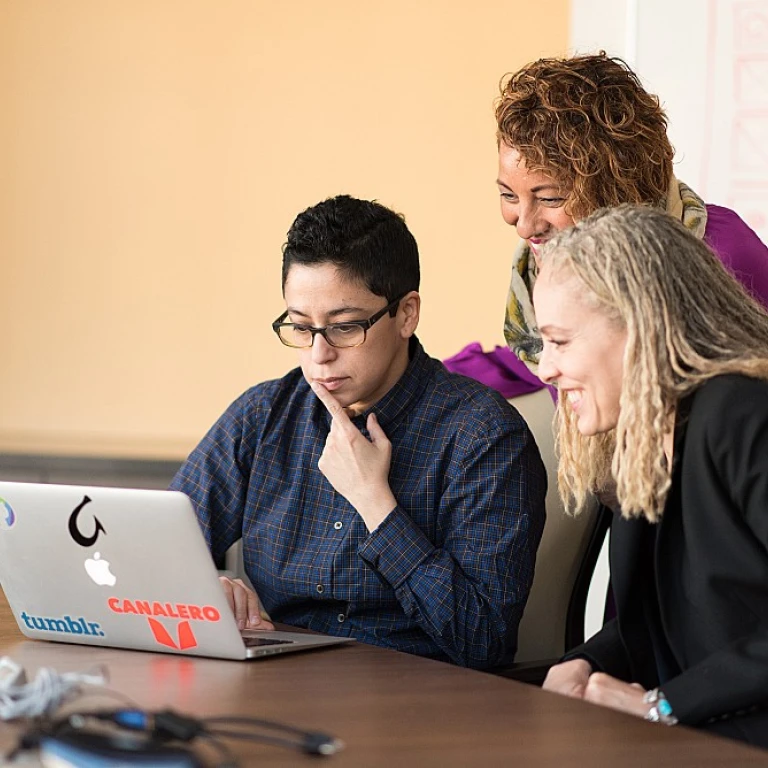
Understanding Blended Learning
Introducing a Balanced Approach
Blended learning combines the best of both worlds: traditional face-to-face instruction and online learning. This hybrid approach to education is increasingly popular as it provides students with a flexible, effective way to develop new skills.Mix of Learning Methods
In a blended course, students often attend classes on campus while also engaging in web-based instruction. This means that time spent in a classroom is complemented by interactive online modules, allowing students to work through the material at their own pace. The variety in teaching methods keeps students engaged and can lead to better retention of information.Flexibility and Personalization
One of the main attractions of blended learning is its flexibility. Courses require students to participate in both scheduled class times and self-paced online activities. This approach can be particularly beneficial for those who balance multiple responsibilities, such as work and family.Resources and Tools Available
Blended teaching utilizes an array of resources such as videos, readings, and interactive assignments that cater to different learning preferences. Additionally, students complete these assignments online, allowing for immediate feedback from instructors, which enhances the learning experience. A diverse array of resources also enables instructors to tailor their teaching in a way that was not possible in a fully traditional classroom setting. For more tips on how blended learning can be adapted amidst the current remote work trends, visit navigating the challenges of remote work in training and development.Benefits of Blended Learning for Upskilling
Advantages of Blended Learning in Skill Enhancement
Blended learning offers a dynamic approach to education by combining online and face-to-face instruction, significantly impacting upskilling efforts. It seamlessly integrates the flexibility of online courses with the personal interaction of classroom settings, creating a hybrid learning environment. Blended learning courses provide students with the benefit of flexibility. For those with tight schedules or commitments that limit their ability to attend traditional classes, online components allow learning to happen at the student's own time and pace. This flexibility extends class time beyond the traditional campus or classroom setting, enhancing access to learning opportunities. Furthermore, blended courses optimize the allocation of resources. By reducing the need for fully in-person classes, schools and organizations can leverage digital resources and minimize physical infrastructure requirements. This can lead to more efficient teaching and a reduction in costs associated with classroom-based learning. Another significant benefit is the enhancement of student engagement. Combining online learning with face-to-face interactions promotes a more engaging learning experience. Web-based assignments and fully online activities encourage students to actively participate, fostering critical thinking and making the learning process more interactive. For personalized learning paths, blended learning courses offer customization options that address individual learning needs. As students engage with both digital forums and in-person interactions, they receive personalized instruction tailored to their specific skill enhancement requirements. Blended teaching methods can also significantly enhance teaching strategies by allowing instructors to use diverse instructional techniques, including flipped classrooms. Students often complete tasks online and use class time for hands-on activities, face-to-face discussions, or testing center tasks, which have proven to enhance understanding by reinforcing learning and application of new skills. As more educational institutions and businesses turn to hybrid and blended approaches, the benefits become increasingly evident, particularly in terms of flexibility, resource efficiency, and heightened engagement. To explore more about the emerging dynamics in the field, consider checking the impact of current global trends on upskilling practices here.Challenges in Implementing Blended Learning
Overcoming Obstacles in Blended Learning Integration
Blended learning courses have become an appealing option for many institutions, yet they face some notable challenges in implementation. The unique approach that combines face-to-face class sessions with online instruction requires both students and educators to adapt to new teaching and learning environments. Here are some hurdles that typically arise:- Resources and Infrastructure: Successful blended learning hinges on having the right technological infrastructure. This includes adequate online platforms for students to access learning courses and resources, and updated classroom facilities to support hybrid teaching methods. Institutions must invest in robust web-based learning management systems and ensure reliable internet access for both students and staff.
- Time Management: Students often struggle with managing their time effectively in a blended course format. Unlike traditional classroom settings, blended learning requires significant self-discipline as students complete assignments independently. Clear communication from instructors about course requirements and schedules can alleviate this issue.
- Instructor Training: Educators accustomed to traditional methods might need additional training to effectively utilize online tools and resources. Blended teaching involves more than just delivering content; it also includes facilitating online discussions, creating interactive assignments, and providing timely feedback to enhance student engagement and learning outcomes.
- Student Engagement: Maintaining high levels of student engagement in online courses can be tough. Interactive elements and diverse teaching methods—such as flipped classroom strategies—can help sustain interest and enhance the online learning experience.
- Assessment and Feedback: Implementing fair and effective assessment methods in a blended learning course is complex. Students often partake in both classroom-based and online testing, and ensuring that these assessments are consistent in difficulty and feedback is vital. Institutions may also consider using a testing center to standardize assessments across different sections.
Strategies for Effective Blended Learning
Developing a Flourishing Blended Learning Strategy
Implementing a successful blended learning approach requires more than just a mix of online and face-to-face instruction. It demands a strategic integration of resources, technology, and teaching methodologies to maximize learning outcomes. Here are some effective strategies to ensure meaningful learning experiences through blended courses:
- Customize Content Delivery: Tailoring content to suit both online and in-person formats is crucial. Instructors need to identify which components of the curriculum are better suited for classroom interaction and which can be effectively delivered through online learning. This judicious allocation of resources aids in maintaining student engagement across both platforms.
- Utilize Interactive Technologies: Leverage web-based tools and platforms that facilitate interaction and collaboration. Technologies such as virtual classrooms, discussion forums, and collaborative assignments can enhance the learning experience by fostering communication between students and instructors beyond physical class time.
- Implement Flexible Structures: Consider adopting hybrid or flipped classroom models that allow students to attend at their own pace. Online courses should provide flexibility for learners to complete assignments and participate in discussions at times that suit them while maintaining the rigour of traditional classroom settings.
- Focus on Assessment and Feedback: Regular assessments and timely feedback are pivotal in evaluating student progress in blended learning environments. Using tools like online quizzes, projects, and peer reviews can offer students continuous feedback, helping them to develop necessary skills for their courses.
- Promote Instructor Support and Training: Instructors should be well-equipped with the necessary skills for blended teaching. Professional development opportunities and continuous support enhance instructors' ability to effectively deliver blended courses and adapt to evolving technologies.
In conclusion, the strategic implementation of these methods will empower instructors and students alike, creating a rich learning ecosystem that balances the best of both online and classroom interactions.
Case Studies: Successful Blended Learning Models
Case Studies of Blended Learning in Action
To truly understand the impact of blended learning approaches on upskilling, examining real-world applications is invaluable. Here are some notable examples:University-Level Hybrid Courses
Many universities have pioneered the shift towards blended learning by offering hybrid courses that combine online and face-to-face instruction. Students attend classes on campus while completing additional assignments through online platforms. This method provides flexibility and allows students to manage their class time effectively. Institutions leveraging blended courses often see increased student engagement and improved learning outcomes as students apply theoretical knowledge through practical activities both in-class and online.Corporate Training Programs
Several organizations have embraced online learning to augment their in-person training modules. By incorporating a flipped classroom model, companies offer employees the chance to access learning courses at their own pace before engaging in face-to-face discussions or practice sessions. This integration of blended teaching methods enhances the learning experience by providing a broader range of resources, such as web-based instruction and interactive elements. As a result, employees often develop crucial skills more efficiently, catering to their personal learning preferences.Vocational and Technical Education
Blended learning also makes significant strides in vocational and technical education, where practical skills are crucial. Training centers implement a hybrid approach, merging online coursework with hands-on, face-to-face workshops or labs. This flexibility in course delivery helps students complete their learning requirements while accommodating their existing schedules. Blended courses in this field often emphasize application-based learning, ensuring that students are job-ready and equipped with the necessary skills. These examples underscore the potential for blended learning to effectively address various educational needs, tailored to the flexibility and resources of the institution or organization involved. By implementing a mix of online and classroom instruction, these models maximize the benefits of both worlds.Future Trends in Blended Learning for Upskilling
Advancing Towards the Future: Emerging Trends in Blended Learning
As we look to the future of blended learning, the landscape is rapidly evolving, driven by technological advancements and changing educational needs. Let's explore some of the most notable trends shaping the future of upskilling through blended learning approaches.Integration of Advanced Technologies
Artificial intelligence and machine learning are increasingly being integrated into blended learning models, providing personalized learning experiences. Adaptive learning systems are tailoring online courses to fit the individual needs and skills of each student, optimizing how students learn. These technologies are majorly contributing to the effectiveness and efficiency of online blended and hybrid courses.Expansion of Web-Based Resources
The availability and accessibility of online resources continue to grow, offering students a wealth of information at their fingertips. From interactive learning platforms to open educational resources, learners can engage with an array of materials beyond traditional textbooks. This abundance of web-based content enriches blended instruction and supports the diverse needs of students, whether they attend class on campus or remotely.Increased Focus on Soft Skills
While technical skills remain important, there's a rising focus on developing soft skills such as communication, problem-solving, and teamwork. Blended courses are adapting to include elements that encourage students to engage in group projects, discussions, and face-to-face interactions, even within a virtual environment. Students complete assignments that develop these vital interpersonal skills, bridging the gap between technological proficiency and human-centric competencies.Greater Emphasis on Modular and Microlearning Techniques
Educational formats like microlearning are gaining traction within blended learning models. These formats break down course content into manageable, bite-sized pieces that can be consumed at the student's convenience, making it easier to learn complex topics over class time. This trend is in line with the move towards more flexible, on-demand learning systems.Shift Towards Competency-Based Learning
Competency-based learning is influencing the design of blended courses, ensuring that students demonstrate mastery of skills before progressing. This approach is highly personalized, allowing students to advance at their own pace and ensuring that they are truly equipped with the necessary knowledge to succeed in their career paths.The future of blended learning in upskilling embraces a holistic approach to education, integrating technology, flexibility, and a focus on developing well-rounded individuals. As blended teaching evolves, it will continue to offer robust and adaptable frameworks for students and professionals alike, ensuring that they can thrive in a dynamic and ever-changing world.












